Texas Railroad History - Towers 92 (New Braunfels),
205 (Austin) and
206 (San Marcos)
Three Junctions of the International &
Great Northern and the Missouri - Kansas - Texas Railroads Between Austin and New
Braunfels
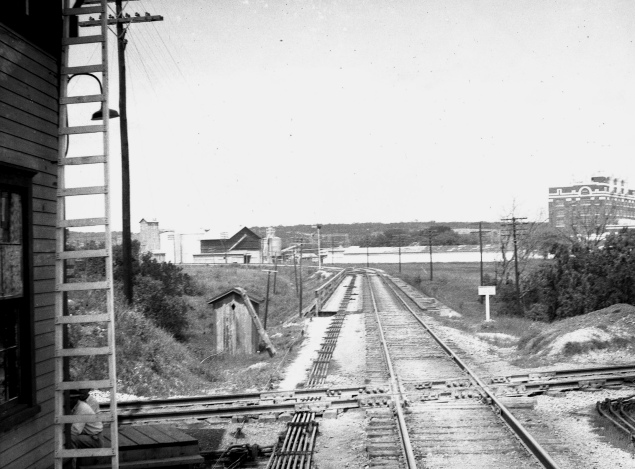
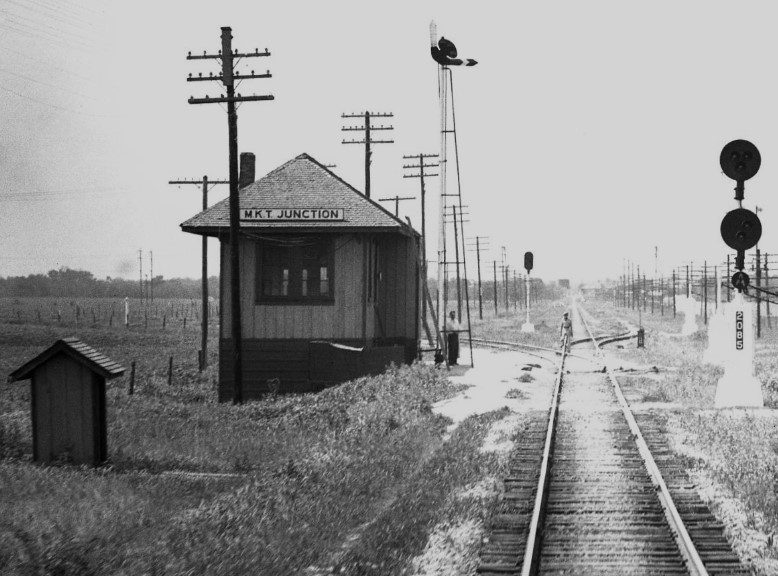
Above:
Railroad executive John W. Barriger III took these two photos from the rear
platform of his business car as he headed northbound on International & Great
Northern (I&GN) tracks between San Antonio and Austin. The image at
left
was taken beside Tower 92 at New Braunfels. Although Barriger is looking at the
southbound tracks to San Antonio, his view at the moment is to the northwest
because of two sweeping curves the I&GN makes in New Braunfels resulting in a
generally east/west transition through downtown. The crossing diamond in the
foreground carries the tracks of the Missouri - Kansas - Texas (MKT, "Katy")
Railroad to San Antonio (to the left) and San Marcos (to the right). The white
sign at right presumably warns pedestrians to stay off the bridge over Dry Comal
Creek just beyond the sign. The large building in the distance is the Comal Power
Plant, a lignite-burning facility built in 1925 that has since been
decommissioned and converted to
apartments.
The image
above right
faces the "M.K.T. Junction" cabin at San Marcos where a connector to
Katy rails can be seen branching off the I&GN to the left, just beyond the
south side of the building. Again, Barriger's view is along the southbound
I&GN tracks toward San Antonio, facing geographically southwest. The first cabin at
MKT Junction began operation on August 1, 1912, but whether it is the structure
in this photo is unknown. It was manned by I&GN personnel. Perhaps fifteen to
twenty years after this photo was taken, MKT Junction was interlocked and became
Tower 206 in the Railroad Commission of Texas (RCT) interlocker assignment list.
Since the two railroads touched at both New Braunfels and San Marcos, the I&GN and Katy employee timetables
show Towers 92 and 206 being 18.6 and 18.7
miles apart, respectively.
Both of the above images are from the I&GN album in the John W Barriger III
National Railroad Library. The photo sequencing in this album does not permit any inference as to whether these photos were
taken on the same trip. They certainly could have been, and they undoubtedly date from the 1933 - 1941 timeframe
when Barriger served in the
Reconstruction Finance Corporation as the chief
administrator for railroad investments.
Below Left: On a different
trip, Barriger took this photo of the railroad control tower at the north end of the Colorado River bridge
in Austin as his train was heading south toward San Marcos. Presumably this was
many years prior to 1956 when RCT designated the building as Tower
205. Below Right:
Although this image of Tower 92 certainly resembles Barriger's work, the
photographer has not been determined. The camera is facing southeast along the
northbound I&GN tracks toward San Marcos, a few dozen yards west of Tower 92. On
this side of the tower, the Katy tracks cross the I&GN leading to San Antonio
(to the right) and San Marcos (to the left.) The photographer is on the bridge
over Dry Comal Creek. The back of the sign warning pedestrians to stay
off the bridge is visible at left. (New Braunfels Historic Railroad and Modeler's
Society collection, courtesy Jim Burns)
All photos on this web page
that were taken by John W. Barriger III are used courtesy of the
John W. Barriger III
National Railroad Library
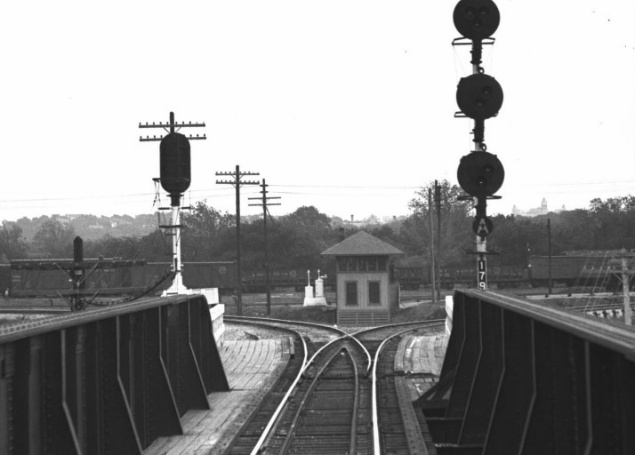
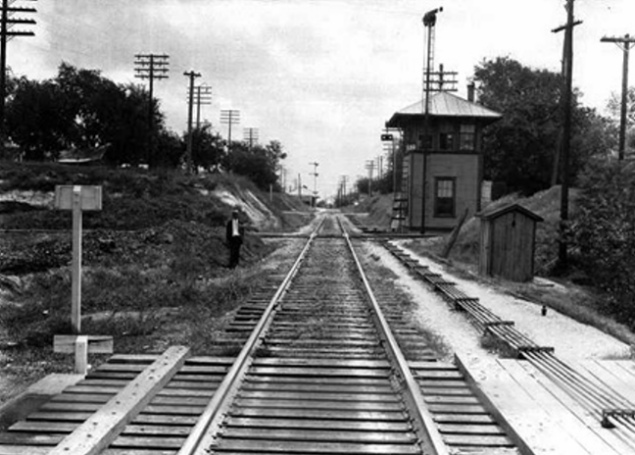
San Antonio and Austin were two important towns in
early Texas history, but their inland locations meant that they would not be
among the first to be served by Texas railroads. Rails and ties are
heavy, hence railroad construction was typically limited by cost-effective
transportation options, e.g. existing railroads or river steamboats (and using
the Colorado River to ship materials to Austin was not an option; it was not
navigable by ordinary steamboats due to a huge "timber raft" that blocked the
river six miles above its mouth at Matagorda.) Austin's first railroad finally
arrived in 1871, a westward branch (from Hempstead) off the
Houston & Texas Central (H&TC) Railroad main line out of
Houston, to which rails and ties could be delivered by steamboat using Buffalo Bayou. Similarly,
San Antonio's first railroad arrived from the east
in 1877, an extension of the Galveston, Harrisburg & San Antonio (GH&SA) Railway
out of Harrisburg, a river port on Buffalo Bayou.
The need for a north/south rail line to connect Austin and San Antonio, roughly
seventy-five miles apart, was recognized, but this need would not be satisfied for several
years.
Austin's second railroad arrived in 1876 in the form of the International & Great Northern
(I&GN) Railroad, building south with plans to continue to San
Antonio and Laredo. The I&GN was the combination of two unrelated railroads,
the International Railroad and the Houston & Great Northern (H&GN) Railroad. The
earliest of these, the H&GN, was chartered in 1866 by Houston interests with a
plan to build north to the Red River. Construction was delayed for several
years; major New York banks were reluctant to lend money to
a new Texas railroad during the initial Reconstruction period after the Civil
War. Work finally began in Houston in December, 1870, and by May, 1873, the tracks
had reached Palestine, 151 miles north of
Houston.
The H&GN's arrival into Palestine
marked the third construction team to do so in less than a year! Both of the
other two were crews of the International Railroad arriving into Palestine from
opposite directions. The International had been chartered by investors
interested in building a line from Texarkana to
Laredo, many of whom were also investors in the St. Louis, Iron Mountain &
Southern (SLIM&S) Railway. The SLIM&S was building from St. Louis to Texarkana,
and the International was chartered in August, 1870 to be essentially a Texas extension of the SLIM&S
that would run through Austin and San Antonio to
the Rio Grande river, Texas' border with Mexico. Work commenced at two locations, Hearne and Longview, in 1871. S. G.
Reed in his reference tome A History of the Texas
Railroads (St. Clair Publishing, Houston, 1941) explains why.
Longview was selected instead of
Texarkana as the Texas & Pacific was planning to build from Texarkana to
Longview. Hearne was selected because the H. & T. C. had reached that point. All
the materials except ties, timber and piling, came by steamer to Galveston and
by barge or G. H. & H. [Galveston, Houston & Henderson] to Houston,
thence to Hearne over the H. & T. C. By December 13, 1871, 50 miles had been
completed and by July 12, 1872, Palestine, 90 miles from Hearne, was reached. In
the meantime equally rapid progress was made on the line from Longview to
Palestine, which was completed January 31, 1873.
Before the H&GN had even reached Palestine, the
management of the International saw the value in a combined railroad that would
eventually serve Houston, Austin, San Antonio and Laredo, with favorable
connections to Galveston and
Texarkana. An agreement was reached in December,
1872, and the railroads began operating under a combined management structure
led by Herbert Melville "Hub" Hoxie as General Superintendent of both railroads.
The International's offices were moved from Hearne to Houston so that Hoxie could run both railroads while awaiting the legal permission to
merge. Two years later in March, 1875, the Legislature authorized the new
railroad, the International & Great Northern (I&GN).
That the I&GN would
eventually reach Austin and San Antonio was understood, but the timing thereof
was subject to the vagaries of financing, weather, politics and the national
economy, and that made the citizens of San Antonio no less anxious. Austin had
railroad service, the H&TC from Houston; San Antonio did not -- it was dependent
on stage routes to meet trains in Austin and Columbus. The GH&SA
led by Thomas Peirce (with the unusual ei spelling) had a line from
Harrisburg to Columbus, and had successfully petitioned the Legislature to
modify the GH&SA charter to permit construction west to San Antonio (permission
was granted, but the original requirement to go north to La Grange was retained.) By the time the I&GN
had been formalized in March, 1875, the GH&SA had already extended its tracks
from Columbus to Luling, only 58 miles northeast of San Antonio.
As Peirce
was building west, he received an offer of $100,000 from Comal County if he
would route the GH&SA into New Braunfels, the county seat. The
San Antonio Express of November 12, 1875
discussed this offer, concerned that its acceptance would delay or preempt
the arrival of rails into San Antonio while boosting New Braunfels into a
regional trade destination to the detriment of San Antonio. The real concern was
that Comal County's proposal was attractive -- New Braunfels was
only 30
miles due west of Luling, roughly half as far as San Antonio. With the I&GN
known to be headed to Austin and farther south, New Braunfels would
become a thriving railroad junction with the addition of the GH&SA. The extent to which Peirce considered this
offer is undetermined, but his railroad stayed on its planned route, reaching
San Antonio in 1877.
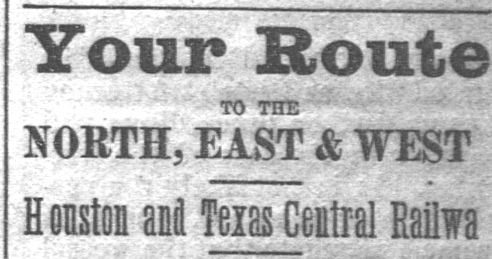
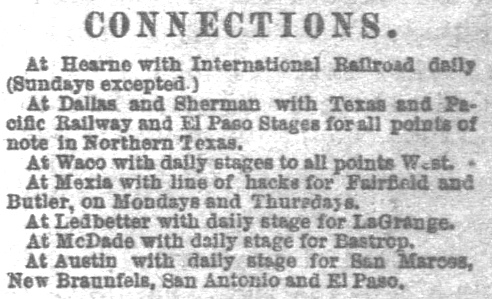 Left:
In the early years, San Marcos, New Braunfels and San Antonio were dependent on stagecoach service
to meet trains in Austin (there were also stages from San Antonio to Columbus
for the GH&SA connection.) The Houston Daily
Mercury of January 1, 1874 carried a schedule advertisement for the H&TC
which also listed its
connections at various stops. Some connections were with railroads (at
Dallas,
Sherman and Hearne), some were with stagecoaches (at
Waco, Ledbetter, McDade and Austin),
and then there was Mexia, which offered a
connection to a "line of hacks" (horses for rent) two
days per week!
Left:
In the early years, San Marcos, New Braunfels and San Antonio were dependent on stagecoach service
to meet trains in Austin (there were also stages from San Antonio to Columbus
for the GH&SA connection.) The Houston Daily
Mercury of January 1, 1874 carried a schedule advertisement for the H&TC
which also listed its
connections at various stops. Some connections were with railroads (at
Dallas,
Sherman and Hearne), some were with stagecoaches (at
Waco, Ledbetter, McDade and Austin),
and then there was Mexia, which offered a
connection to a "line of hacks" (horses for rent) two
days per week!
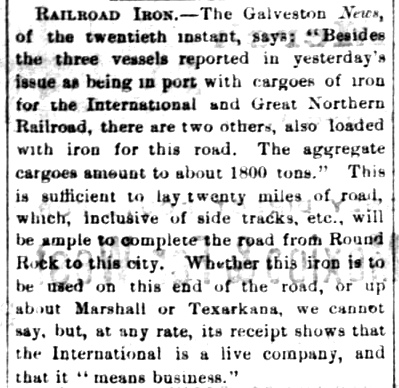 |
Left:
The Austin Weekly Democrat Statesman
carried this news item in its July 27, 1876 edition noting the arrival
at Galveston of 1,800 tons of iron for the I&GN. Speculating that this
would be sufficient to complete the remaining distance for the I&GN to
reach Austin (from Round Rock), the article assures the reader that the
I&GN is a "live company" that "means business." Perhaps rumors of
financial difficulty for the I&GN had already begun to surface.
Right: The
Galveston Daily News of December 17, 1876 describes the
arrival of the first I&GN passenger train into Austin the previous
day as "A Notable Event". The telegram was sent by the
aforementioned "Hub" Hoxie of the I&GN. Hoxie had a lengthy career in railroad management with several
railroads. In later years, he was a close associate of rail baron
Jay Gould. Hoxie died in
New York in 1886 at age 55 due to complications from kidney stone surgery. |
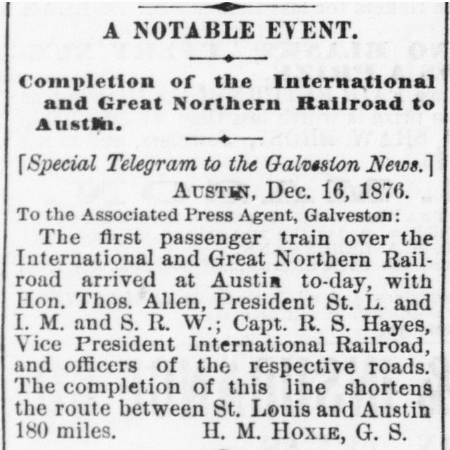 |
The I&GN reached Austin on December 16, 1876 and ...
stayed there. The construction from Hearne to Austin had stretched the company's
finances to the breaking point; it badly needed operating revenue with which to
pay expenses and bond interest. On April 1, 1878, the company was forced into
receivership. After a year and a half in bankruptcy, it was sold at foreclosure
on November 1, 1879 to buyers who formed a new I&GN company under the original
charter and management team. Construction was restarted south from Austin to San
Antonio via San Marcos and New Braunfels with a contract issued to the New
Jersey Contracting Company on May 31, 1880. The contract was successfully
completed at San Antonio on February 16, 1881, and an extension to Laredo was
completed later that year.
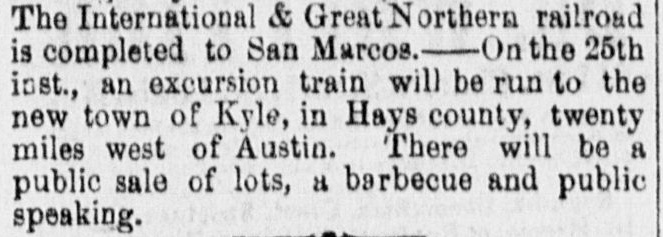
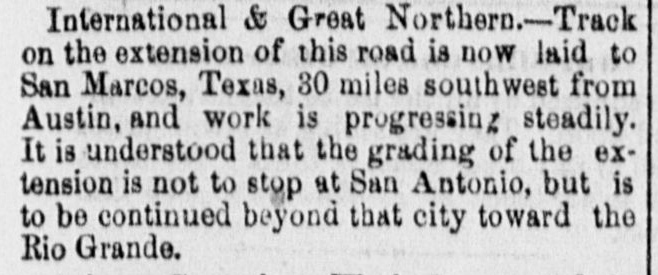 |
Left: In
September, 1880, the Dallas Daily Herald
carried these items (on the 22nd and 29th, respectively) discussing
the arrival of I&GN tracks into San Marcos.
Right: The Galveston Daily News
of October 1, 1880 printed this telegram from San Marcos announcing
passage of the first construction train over the San Marcos River the
previous day, followed shortly by a train with numerous dignitaries. The
telegram congratulated "the rest of mankind" for
having the "good fortune" to have finally begun to reap the
benefits that would instantly flow from the new
connection with the "booming town" of San Marcos. Obviously, San Marcos
didn't need the rail connection; the world
did. Apparently, the presence of U. S. President Rutherford B. Hayes and
Texas Governor James W. Throckmorton in San Marcos was of lesser significance. |
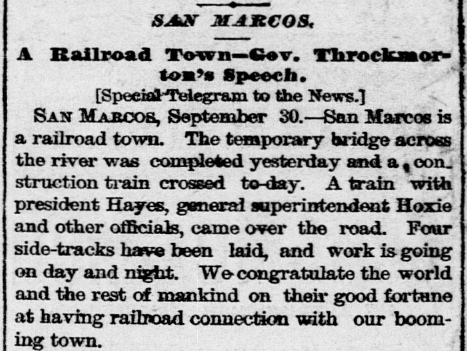 |
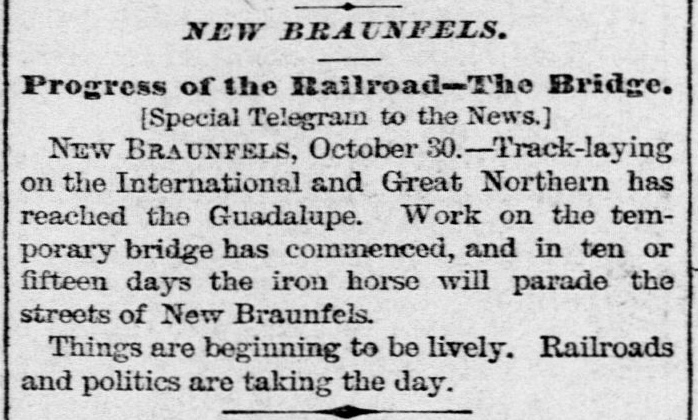 |
Left:
The Galveston Daily News
of October 31, 1880 carried a telegram announcing that I&GN track-laying
had reached the Guadalupe River and that they would arrive in New
Braunfels within the next two weeks. From the north, the I&GN's
construction went to the southeast side of New Braunfels where it made a
sweeping curve to cross the river and turn back to the northwest to enter downtown, about a mile past the bridge.
West
of downtown, the right-of-way then curved back to the southwest to
resume the basic heading toward San Antonio.
Right:
The Galveston Daily News
of November 21, 1880 described the celebration in New Braunfels (with "plenty of lager") for the
high noon arrival of the first train into the city. |
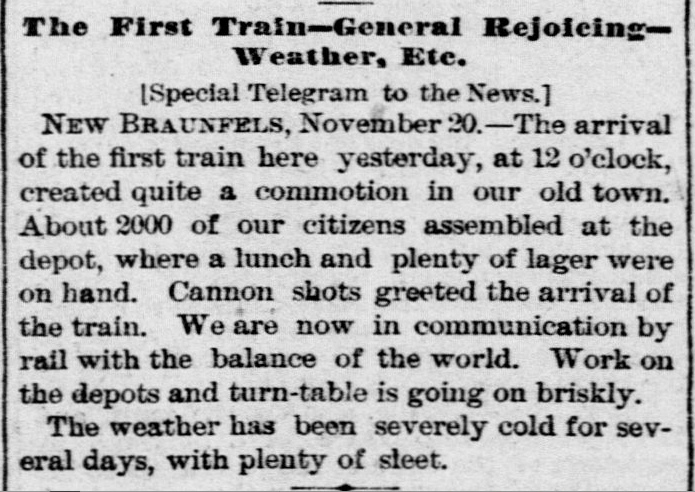 |
In late 1872, the creation of the combined management
structure for the International and the H&GN, and their plan to merge into a
single railroad that would operate
from Texarkana to the Gulf coast and Mexico, had immediately caught the
attention of railroad investor Jay Gould. Gould had Midwest railroads, but he
needed an outlet to Mexico and ports on the Gulf to maximize their potential. In 1873, he
began eyeing the Missouri, Kansas & Texas (MK&T, "Katy") Railroad as a
potentially valuable property with which to overtake the I&GN and conquer Texas
railroading. Author Wayne Cline in his 2015 book The
Texas Railroad explains that Gould's plan to quietly take over
the Katy began on October 22, 1873 when...
"...he stage-managed the election
of a loyal ally, William Bond, as the road's second vice president. Bond
proceeded to fire key Katy managers and replace them with Gould's henchmen. On
December 21, 1874 Bond was appointed receiver of the MKT, and on March 1, 1876
he became the Katy's general manager. By December, 1879, Bond had brought so
many Gould supporters aboard the MKT that Jay was elected president."
Gould likely adopted this strategy because buying a
controlling interest of Katy stock was infeasible. The
stock had become so diluted and widely dispersed among so many small
stockholders that there were few large blocks available for private purchase,
and there simply
weren't enough shares circulating on the open market. As a result, Gould had
little ownership interest in the Katy, he was merely its President. To ensure
his continued control, Gould leased the Katy in December, 1880 to the Missouri
Pacific (MP) Railroad, a large Missouri-based railroad that he controlled and in
which he had a large ownership position. As Gould planned an expansion of the
Katy deep into Texas, he intended to use it to route long-haul traffic to and
from MP. And what did the Katy get
in return for agreeing to be leased? It got to keep its net profit, no matter
how meager it might be as a result of accounting and operating policies tilted
heavily toward MP. MP stockholders (mostly Gould) would reap the benefits; Katy stockholders
would get nothing.
In parallel with the
Katy, Gould was also targeting the Texas & Pacific (T&P) Railway which was
building west from Texarkana to El Paso via Marshall on a Federal charter that
authorized construction to San Diego. The T&P tracks had already passed through
Longview; the I&GN depended on the connection there for access to St. Louis
traffic through Texarkana. The T&P was stuck at Ft. Worth, unable to build
farther west for lack of funds, and this presented Gould with an opportunity. He
created a construction company and offered to build the T&P line west of Ft. Worth in exchange for
$20,000 in T&P stock and $20,000 in T&P bonds for each mile completed. A deal
was struck, and as construction proceeded west out of Ft. Worth, Gould's ownership and influence
over the T&P increased with each mile. In April, 1881, Gould formally took over the T&P.
Gould needed one other railroad in his pocket before attempting to take on
the I&GN. It was the aforementioned SLIM&S, which operated the connection
between Texarkana and the outskirts of St. Louis. His plan was simple; at the
south end, Gould began to use the Katy's line through Oklahoma to carry T&P
traffic bound for St. Louis. Normally, this interchange would be with the SLIM&S
at Texarkana, thus depriving that railroad of critical northbound traffic.
Near St. Louis, Gould bought the terminal railroad that provided the final
connection for the SLIM&S into St. Louis, positioning him to create mischief.
In December, 1880, the SLIM&S ownership ultimately gave in and sold a large block of stock to
Gould, giving him about 30% of the company. They did not further resist Gould's control
and he assigned the SLIM&S to become part of MP.
By February,
1881, as I&GN construction reached San Antonio and connected with the
GH&SA, Gould had already begun negotiations with the I&GN to buy a controlling
interest. On June 1, 1881, it was announced that the Katy railroad had acquired all of
the I&GN common stock in a two-for-one stock swap, and had transferred the
I&GN stock to Ft. Worth resident Gen.
Grenville Dodge. Dodge was a friend of Gould's, a famous Army General who had
been the chief engineer for numerous railroads including the Transcontinental
Railroad. The transfer was done to get around Texas' law requiring companies
owning tracks in Texas to be headquartered in Texas. The Katy was based in
Kansas and did not have a Texas railroad charter. It was only allowed to operate
in Texas because, to incentivize the Katy to build to the Red River and cross
into Texas, the Legislature in August, 1870 had granted recognition of the
railroad charter issued to the Katy by the State of Kansas. It was open question
as to whether the Katy had the same property ownership rights as other Texas
railroads (or any rights at all.) With Gen. Dodge ostensibly owning the I&GN
by possession of all of its stock, Gould arranged for the Katy
to lease the I&GN for 99 years. Thus, without using any of his own money, Gould
had simultaneously acquired the I&GN and circumvented Texas' law prohibiting track
ownership by "foreign" corporations.
Leasing to the Katy
effectively added the I&GN's
network (the largest in Texas) to the routes in Texas that MP was operating
under its lease of the Katy.
MP was a "foreign" railroad; it did not own any tracks in Texas -- they were all Katy and I&GN tracks under
lease. The I&GN continued to build and operate under its
own name whereas MP became the "face of the franchise"
for all Katy activities. Under Katy ownership, tracks were extended south by MP from
the Katy's Red River crossing near Denison to
Fort Worth (1880), from there
south to Hillsboro (1881), and then farther south to Taylor via
Waco (1882). There were also two Katy extensions
into Dallas.
Among the Texas press, all of this work was publicly associated with MP, not
the Katy. The junction at Taylor was viewed as a MP / I&GN junction even
though they were both part of the same enterprise. The Katy's Kansas charter
explicitly called for construction south through Waco and Austin to reach the
Rio Grande River; Gould was aggressively following this plan (not that he
considered himself bound by it.) Texas officials
wanted more railroads in the state, even if it meant not questioning the
legality of MP's southward expansion of Katy's route network; neither
railroad was headquartered in Texas and neither had a Texas charter.
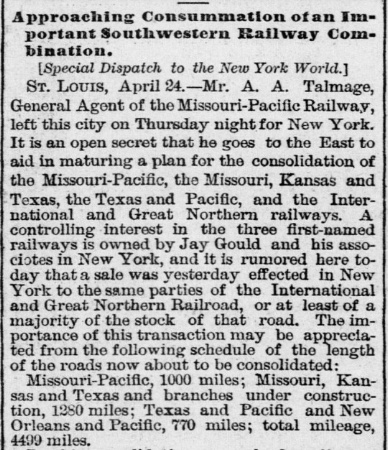 |
Left:
The Galveston Daily News of
April 30, 1881 carried this article from six days earlier out of St.
Louis speculating on a complete merger of MP, the Katy, the T&P and the
I&GN, repeating the rumors that the I&GN had already been sold to Gould.
Right:
Ironically, the same issue of the
Galveston Daily News carried this article discussing H. M.
Hoxie's assignment to be the new General Superintendent of the T&P. As
noted earlier, Hoxie had been the G.S. of the I&GN since the beginning
and he had been the author of the telegram sent to newspapers
publicizing the arrival of the first I&GN train into Austin in December,
1876. So why was Hoxie suddenly the T&P's G.S. while remaining as G.S.
of the I&GN? Gould had formally taken over the T&P during its annual
stockholders' meeting held in Philadelphia in April, 1881. By naming
Hoxie as the T&P's new G.S. starting May 1, Gould ensured that the I&GN
would begin coordinating with the T&P (and thus, with all of his
railroads), even if the deal to add the I&GN to the Gould enterprise was
not yet complete. |
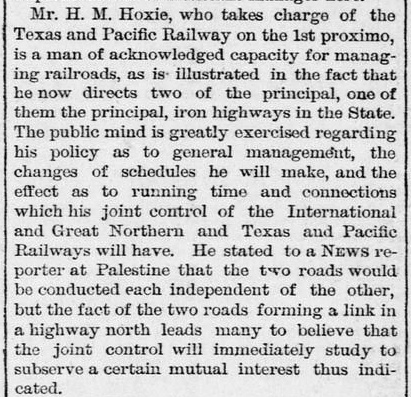 |
Gould's southward construction
plan for the Katy was in pursuit of MP service to both Mexico and Houston via the Katy's
Red River bridge. This route provided complementary options, both north and
south of the bridge, compared to the I&GN via Texarkana and Longview. To facilitate Houston access from Denison
quickly, Gould had MP build a Katy extension from Greenville to
Mineola in 1881 where it would connect to an
existing I&GN branch from Troup, a town on the main line northeast of Palestine. [Mineola was
also served by the east/west T&P.] The Denison -
Greenville leg of this route was then acquired in late 1881 by purchasing the
Missouri, Kansas and Texas Extension Railway, one of the lines chartered by Katy
interests prior to Gould's takeover. This meant that Katy traffic over the Red River
bridge had a "Gould all the way" route to Houston via Greenville, Mineola,
Troup and Palestine; it was not ideal but it was better than nothing.
Reaching Taylor
in 1882 gave MP's Katy network a friendly Gould connection to Austin, San
Antonio and Laredo via the I&GN, satisfying one of Gould's objectives. MP's intent was to complete a
route from Taylor to Houston, but for several years, the southern terminus of
the Katy tracks remained at
Taylor. This was mostly due to the political climate in the Texas Legislature,
which in 1882 had repealed the land grant law and lowered authorized passenger
fares while pondering additional railroad regulation. Gould was still planning
for the Katy to reach Houston soon, so he bought the Galveston, Houston &
Henderson (GH&H) Railroad which owned only one line, but it was an important
one: the only set of tracks between Houston and Galveston. Gould reorganized the
GH&H under its original charter and sold it to the Katy to be a direct route to
Galveston, Texas' largest city and largest port. At this point, the Katy had
only reached Taylor, a long ways from Houston, so Gould had the Katy lease the
GH&H to the I&GN. The I&GN and GH&H had interchanged in Houston for many years,
but now those movements would be under a common Gould enterprise.
After four years, MP
resumed construction of Katy tracks out of Taylor by chartering the Bastrop &
Taylor Railway Co. on April 26, 1886. By the time work commenced south out of Taylor
in 1887, the name had been changed to the Taylor, Bastrop &
Houston Railway. Regardless, it was a MP / Katy operation all the way. At Elgin, the tracks crossed the
H&TC line to Austin and continued south to Bastrop where a bridge over the
Colorado River was built south of town. Beyond the bridge, the route took a
southeast heading into Smithville and continued to La Grange, following a route
to Sealy that was surveyed (but never used) by the
Texas Western Railway. Reaching Sealy would put the Katy only 48 miles out of
downtown Houston. However, eleven miles beyond La Grange, construction stopped
at the end of 1887 at a location named Boggy Tank. There was no progress beyond
Boggy Tank for several years as the Gould railroads entered a period of financial turmoil.
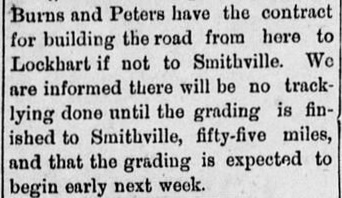 The Katy
tracks through Smithville were within 50 miles of the I&GN tracks at San Marcos.
A line from Smithville west to San Marcos would provide benefits to Gould's railroads by
creating a triangle of track alternatives between Taylor, San Marcos and
Smithville that would be valuable in the event of a bridge failure or other
track problem. Most important, however, was that a Smithville - San Marcos
connection would eventually (when the eastward extension to Houston was
finished) create a Gould route between Houston and San Antonio via Smithville
and San Marcos. Such a route could compete with the GH&SA, and at minimum
would provide
a "Gould only" option for movements between two of Texas' largest
cities. As an added bonus, the town of Lockhart, worthy of rail service as the seat of Caldwell County, was
midway between Smithville and San Marcos. In 1887, MP initiated construction of
Katy tracks between San Marcos and Smithville via Lockhart. Work began at San
Marcos, and the tracks to Lockhart were completed in 1887. But like
the situation at Boggy Tank, further construction from Lockhart to Smithville was paused for
financial reasons.
The Katy
tracks through Smithville were within 50 miles of the I&GN tracks at San Marcos.
A line from Smithville west to San Marcos would provide benefits to Gould's railroads by
creating a triangle of track alternatives between Taylor, San Marcos and
Smithville that would be valuable in the event of a bridge failure or other
track problem. Most important, however, was that a Smithville - San Marcos
connection would eventually (when the eastward extension to Houston was
finished) create a Gould route between Houston and San Antonio via Smithville
and San Marcos. Such a route could compete with the GH&SA, and at minimum
would provide
a "Gould only" option for movements between two of Texas' largest
cities. As an added bonus, the town of Lockhart, worthy of rail service as the seat of Caldwell County, was
midway between Smithville and San Marcos. In 1887, MP initiated construction of
Katy tracks between San Marcos and Smithville via Lockhart. Work began at San
Marcos, and the tracks to Lockhart were completed in 1887. But like
the situation at Boggy Tank, further construction from Lockhart to Smithville was paused for
financial reasons.
Left: The
San Marcos Free Press of May 19,
1887 reported that the construction contract out of San Marcos had been let.
Work stopped before the end of 1887 as Gould faced dark financial clouds, primarily
related to the bankruptcy of the Wabash, St. Louis & Pacific Railway which
he had acquired in the
early 1880s. The problems spilled over to MP because Gould had leased
the Wabash to the SLIM&S, part of the MP family. The more immediate
problem, however, was the election of James S. Hogg in November, 1886 as Texas
Attorney General. A future governor (and the father of semi-notorious
Ima Hogg),
Hogg had
been elected on a campaign to go after Texas railroads for poor service, poor
facilities, price-fixing and other violations of state law. Hogg began by suing
the I&GN on December 3, 1887 for neglecting its infrastructure and delivering
poor (and unsafe) service, in violation of its Texas railroad charter. He also
claimed the I&GN had violated Texas railroad ownership laws by consenting to be
leased (through the Katy) to MP, a "foreign" corporation.
After a 3-day trial, the judge issued a split ruling on June 21, 1888; the I&GN
would not forfeit its charter, but it would no longer benefit from a
charter-based tax exemption. Eighteen months later, the Texas Supreme Court
reversed the ruling on the tax exemption. In the end, Hogg won nothing from this
lawsuit.
Gould may have
temporarily felt safe from the wrath of Hogg, but he was not safe from the
Katy's stockholders. Gould
had leased the Katy to the MP to ensure long term control because he and
his henchmen held very little of its stock. Gould could be tossed out as
President at any time during an unfavorable stockholders meeting. And that is
precisely what happened in May, 1888. The stockholders realized that terrible
revenue divisions, deferred maintenance, and other financial indicators meant
that Gould was extracting every dollar possible out of the Katy and sending it
north to MP, where he held a large ownership position. The Katy was unprofitable simply
because all of its profits were being drained into MP. The Katy stockholders
replaced Gould and all of his cronies, and the new management requested
receivership protection from a bankruptcy court while it reorganized. The court
ruled favorably on assigning a receiver and it invalidated the MP's lease on the
Katy.
The Katy was finally free of Gould, but he would not go quietly.
Most critically, the Katy owned all of the I&GN's stock, even though it
technically had been transferred to Gen. Dodge in Ft. Worth. Gould was in danger
of losing two of his three railroads in Texas, so he proceeded to execute a
clever plan to save his investment in the I&GN. He was still the President of
the I&GN, at least temporarily until its stockholders -- corporate officers of the
Katy -- could call a formal stockholders meeting and fire him. He proceeded to
personally loan the I&GN a half million dollars and ensured that the I&GN did
not pay it back within the time specified. Gould then sued the I&GN for default
and forced it into receivership. The Katy intervened in the court proceedings
and agreed that the I&GN should repay the $500,000 to end the matter, after
which they would oust Gould and his henchmen from the I&GN at a called stockholders meeting. Gould countered by approaching
his adversary, Attorney General Hogg, to
remind him that the Katy was a "foreign" railroad, one that now owned a
bona fide Texas
railroad, the I&GN. Hogg responded by arranging an injunction to prevent the
Katy stockholders from taking any adverse action pertaining to the I&GN. Hogg later
explained that although he had "ascertained" that the Katy controlled all of the
I&GN's stock, he had no "proof positive" until the Katy happened
to file an affidavit
to that effect with the district court overseeing the I&GN receivership.
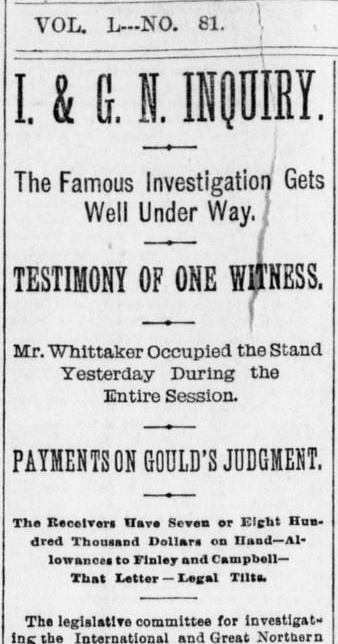 Left:
I&GN drama at the Legislature was always a big story with the
Galveston Daily News, here on June 13,
1881.
Left:
I&GN drama at the Legislature was always a big story with the
Galveston Daily News, here on June 13,
1881.
Gould's ploy had worked; Hogg's injunction was upheld and the
I&GN receivership continued
for many months. Although the receiver and the judge fixed the problems that had led
to Hogg's prior suit against the I&GN, it was still owned by the Katy, and the
judge was ready to terminate the receivership since the I&GN was ready to pay
the debt owed to Gould. Hogg made a final appeal to the Texas Supreme Court -- and
lost -- but the additional delay made a critical difference. By this time (July,
1891), Katy stockholders finally understood their
larger predicament and proceeded to negotiate a settlement
with Gould wherein Gould paid the Katy $350,000 and guaranteed that the I&GN
would resume its prior traffic arrangements with the
Katy. In exchange, the Katy transferred all of the I&GN's stock to Gould.
Why did the Katy give away the I&GN for a paltry $350,000? Because it needed to file a charter with the Texas Legislature (it had never
had one) to clean up the mess resulting from another lawsuit. Authority
to own the I&GN was omitted from the proposed Katy charter simply because it
would not otherwise be approved by the Legislature. The Katy was not going
to be allowed to own the I&GN, so they might as well get rid of it and move on.
The Katy's mess was the aftermath of a lawsuit that Hogg had filed in 1888
against Gould and the Katy for unlawful acquisition and operation of the East
Line & Red River (EL&RR) Railroad, a narrow gauge line that ran from
Jefferson to Greenville. Under Gould's control, the Katy had bought the line in
1881 and extended it 32 miles west to McKinney in 1882. Hogg chose the EL&RR
acquisition as a means of attacking the Katy for being a "foreign" railroad
unlawfully owning a Texas railroad. In February, 1890, Hogg
won the final appeal of his lawsuit at the Texas Supreme Court, causing the EL&RR's
charter to be forfeited and forcing it into receivership. The appellate ruling in Hogg's favor
had concluded that the Katy was, indeed, a "foreign" railroad that lacked
both a Texas charter and a Texas headquarters. The Katy could not continue as a
viable railroad in Texas until this situation was resolved, which could only be
done by the Legislature.
A new Katy charter was filed on October 28, 1891 and approved
by the Legislature establishing the Missouri, Kansas & Texas Railway Co. of
Texas, to be headquartered at Denison as a wholly-owned subsidiary of the
parent Katy corporation. The Texas subsidiary would own all of the Katy's former Texas rail
lines and railroads except the I&GN and the EL&RR (which
was still
in receivership.) When the EL&RR came out of receivership, it was sold in early
1892 to the newly chartered Sherman, Shreveport & Southern (SS&S) Railway owned by investors
based in Greenville and Sherman.
When Jay Gould died in New York City at
the end of 1892, his son George took over the railroad
investments and succeeded Jay as President of both the I&GN and the T&P. Unlike
his father, George Gould attempted to be fair with the Texas railroads. For the
next thirty years, the I&GN and the T&P would operate under Gould family control
and work cooperatively with the Missouri Pacific on Midwest traffic.
And
what became of General Hogg? He was elected Governor in 1890 on a platform advocating creation of the
Railroad Commission of Texas.
On sound legal and financial footing, the newly independent Katy resumed
construction in 1892, building from Boggy Tank to the Brazos River, seven miles
beyond Sealy. The remaining 42 miles of track from the Brazos River to Houston
was laid the following year. Now with tracks
into Houston, the Katy was very interested in operating to Galveston, but the
GH&H was still leased to the I&GN which the Katy no longer owned. The Katy claimed in a Federal lawsuit that it
had a continuing right to operate the GH&H, and when all of the legal dust
settled, the Katy and the I&GN each owned 50% of the GH&H with rights to operate
independently over it.
Also in 1892, the Katy completed the Smithville -
San Marcos line by finishing the 36 miles between Lockhart and Smithville. This
enabled it to establish service to San Antonio via the I&GN connection at San
Marcos. The two railroads seemed content to continue that arrangement, but in
1899, a revision to the Katy's charter required it to extend its tracks to San
Antonio. The Katy didn't ask for this requirement; it was added when the Katy
requested a charter revision to authorize it to re-acquire the former EL&RR, now the SS&S, between McKinney
and Jefferson. The charter provision was written so that the SS&S purchase could not proceed until the Katy
had extended its tracks from San Marcos to San Antonio. The nature of this
serial requirement to operate into San Antonio before being allowed to buy the SS&S suggests
that the
provision was added by San Antonio legislators concerned about
the lack of railroad competition for the I&GN on routes to the north. The law
also had a unique provision found in no other railroad charter in Texas. By
accepting permission to acquire the SS&S, the Katy agreed to be permanently prohibited
from filing, or participating in, any lawsuit against the Railroad Commission of
Texas. The Katy fulfilled its obligations; newspapers report the
beginning of construction out of San Marcos on September 12, 1900 and the
completion of the
46 miles to San Antonio on April 25, 1901.
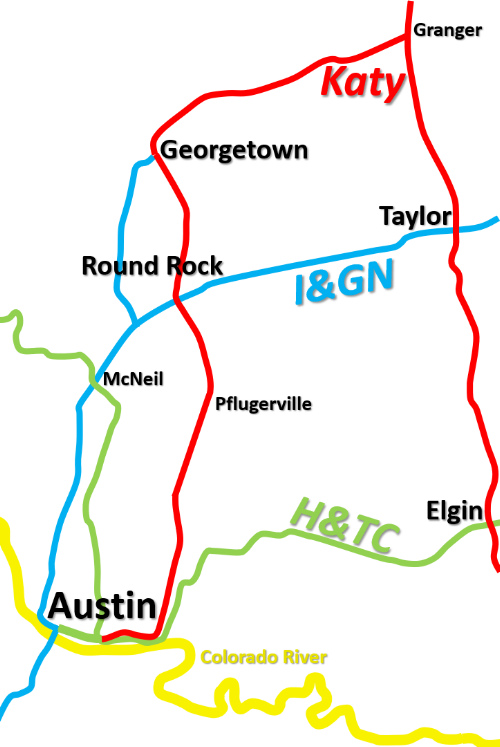 The Katy
now had tracks from the Red River to San Antonio
via Smithville, but did not serve Austin, the state capital. To do
so, it acquired two defunct railroads that had never laid tracks: the
Georgetown & Granger (G&G) Railroad and its owner, the Trinity, Cameron &
Western Railroad. The Katy did this to retire the G&G charter, which authorized
a line between Granger, on the Katy main north of Taylor, and Georgetown, the
county seat of Williamson County, 25 miles north of Austin. Retiring the G&G
charter enabled a new railroad to be chartered, the Granger, Georgetown, Austin & San Antonio Railway,
which built 16 miles from Granger east to Georgetown in
1903. At Georgetown, the Katy connected with a 10-mile I&GN branch line, the
former Georgetown Railroad (GRR) from Round Rock, which the I&GN had acquired out of foreclosure and merged in 1882. The Katy built the remaining distance to
Austin in 1904, going south through Round Rock, Pflugerville and
eastern Travis County before curving west to approach downtown. In July, 1905, the Katy negotiated rights to share the I&GN bridge over
the Colorado River along with 30 miles of I&GN track south to reach Katy's rails
at San Marcos. This enabled the Katy to provide direct passenger service between Austin and San
Antonio. Three months later, the Austin Statesman
of October 4th reported on the I&GN's new Colorado River bridge under construction,
remarking that it was "...hardly possible that the new...railroad bridge will be
finished by the 1st of January, as was first expected. Work on the bridge,
however, is progressing very rapidly." Most likely this bridge replaced the
original structure that had been built 25 years earlier.
The Katy
now had tracks from the Red River to San Antonio
via Smithville, but did not serve Austin, the state capital. To do
so, it acquired two defunct railroads that had never laid tracks: the
Georgetown & Granger (G&G) Railroad and its owner, the Trinity, Cameron &
Western Railroad. The Katy did this to retire the G&G charter, which authorized
a line between Granger, on the Katy main north of Taylor, and Georgetown, the
county seat of Williamson County, 25 miles north of Austin. Retiring the G&G
charter enabled a new railroad to be chartered, the Granger, Georgetown, Austin & San Antonio Railway,
which built 16 miles from Granger east to Georgetown in
1903. At Georgetown, the Katy connected with a 10-mile I&GN branch line, the
former Georgetown Railroad (GRR) from Round Rock, which the I&GN had acquired out of foreclosure and merged in 1882. The Katy built the remaining distance to
Austin in 1904, going south through Round Rock, Pflugerville and
eastern Travis County before curving west to approach downtown. In July, 1905, the Katy negotiated rights to share the I&GN bridge over
the Colorado River along with 30 miles of I&GN track south to reach Katy's rails
at San Marcos. This enabled the Katy to provide direct passenger service between Austin and San
Antonio. Three months later, the Austin Statesman
of October 4th reported on the I&GN's new Colorado River bridge under construction,
remarking that it was "...hardly possible that the new...railroad bridge will be
finished by the 1st of January, as was first expected. Work on the bridge,
however, is progressing very rapidly." Most likely this bridge replaced the
original structure that had been built 25 years earlier.
Left: The three main railroads in the Austin area
as of 1904 were the H&TC, owned by Southern Pacific (SP), the Katy, and the
I&GN. At Round Rock, the Katy crossing of the I&GN main line was
grade-separated, the Katy passing over the I&GN. The Katy crossings
at Taylor and Elgin were both at grade, and they became interlocked as
Tower 34
and Tower 100, respectively. The grade crossing of the I&GN and the H&TC at McNeil was
eventually interlocked as Tower 132. The Katy
intersected the H&TC east of downtown Austin, a non-interlocked junction
known as Pershing. From
there, the Katy used the H&TC tracks into downtown to connect with the
I&GN.
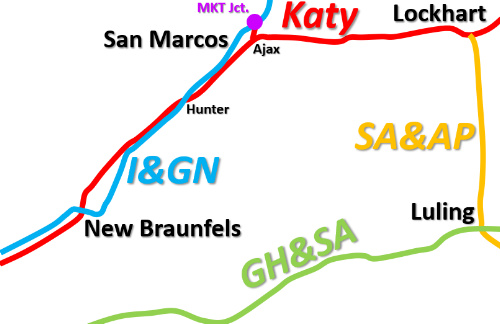
Right: MKT Junction was
the branch point on the I&GN main line for the half-mile run to Katy rails at Ajax, where a
triangle track arrangement permitted connecting movements in all three
directions.
South of San Marcos, the Katy crossed the I&GN twice. At
Hunter, the I&GN has had a bridge over the Katy since at least 1915, but
the pre-1915 track arrangement is undetermined. The second crossing is at
grade in New Braunfels, where Tower 92 was later built as a manned, 2-story
interlocking tower.
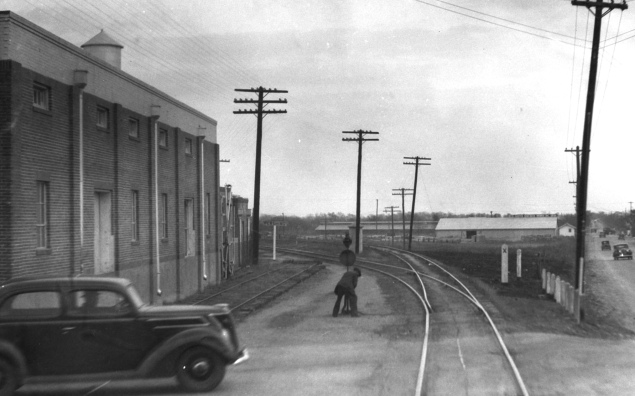
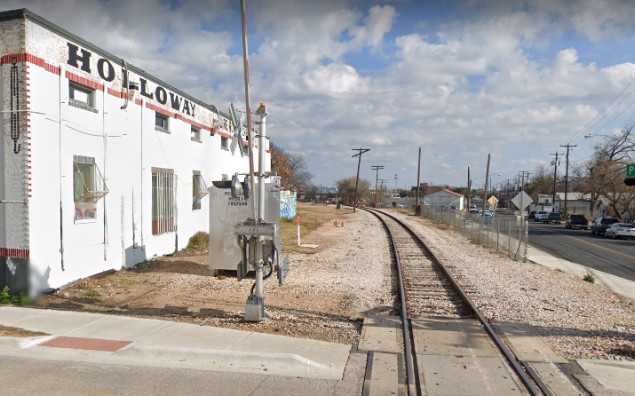
Above Left: Coming into Austin
on the Katy, Barriger took this photo just as his business car cleared the
switch at Pershing and crossed Pedernales St. His camera faces east as his train
is moving west toward downtown. A switchman, presumably an SP employee, has
begun to move the switch back to its normal position to allow straight-ahead
movements on SP's main track toward Houston via Brenham
and Hempstead. To the left beyond the switchman, the sign atop the white pole
next to the Katy tracks reads "PERSHING". The Katy came south through eastern
Travis County and then paralleled the H&TC for the last three miles into Pershing.
Above Right: This Google Street View image from 2021
shows that the Katy tracks are gone, but the adjacent building has
survived for ~ 80 years and perhaps some of the utility poles have as well. The
street to the right parallel to the former SP tracks is East Fifth St.
Below: A quarter mile farther west, Barriger's next photo is
facing east at Austin Jct. (as the horizontal sign reads.) This was the wye junction for SP trains to
go north to Burnet, Llano and Marble Falls on the former Austin & Northwestern line,
a right-of-way that is now used by Austin's
CapMetro commuter rail system. There were two tracks on the west side of the
wye going north, and Barriger's business car has just cleared the switch for the
inner track. The passenger cars sit on the outer track, which was removed
sometime in the 1940s; that real estate is now occupied by buildings. Barriger's
business car is about to cross Canadian St., now Robert T. Martinez Jr. St.
Continuing west into downtown, SP's track will transition a block south to
Fourth St., and then transition again to Third St. to reach the passenger depot
at the corner of Third St. and Congress Ave. Continuing west beyond the depot,
the tracks on Third St. lead to a wye for access to I&GN's Colorado River
bridge.
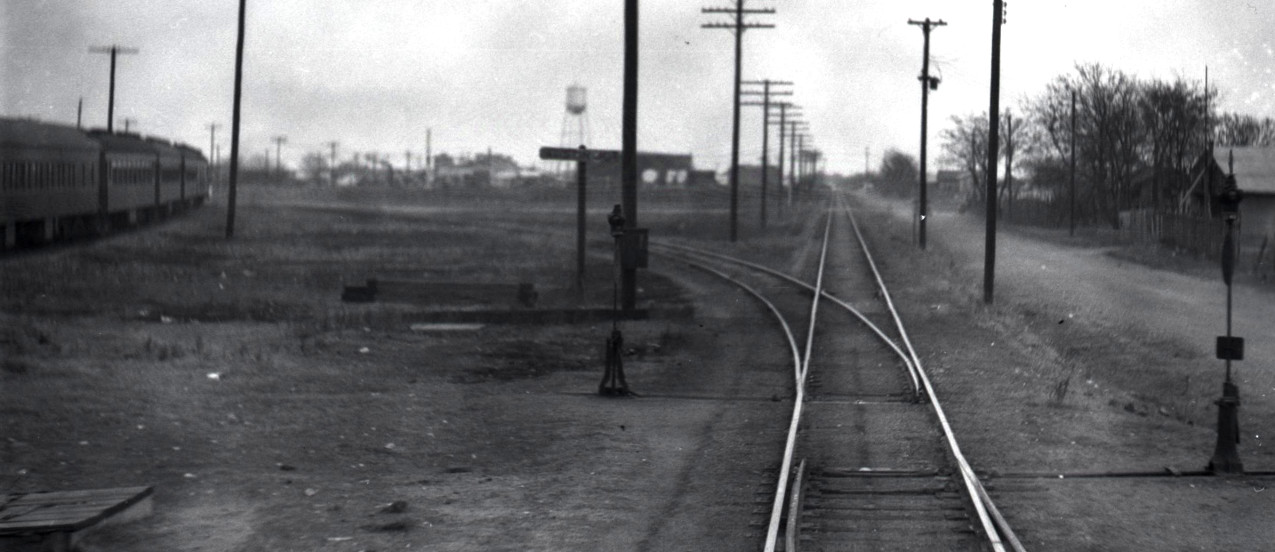
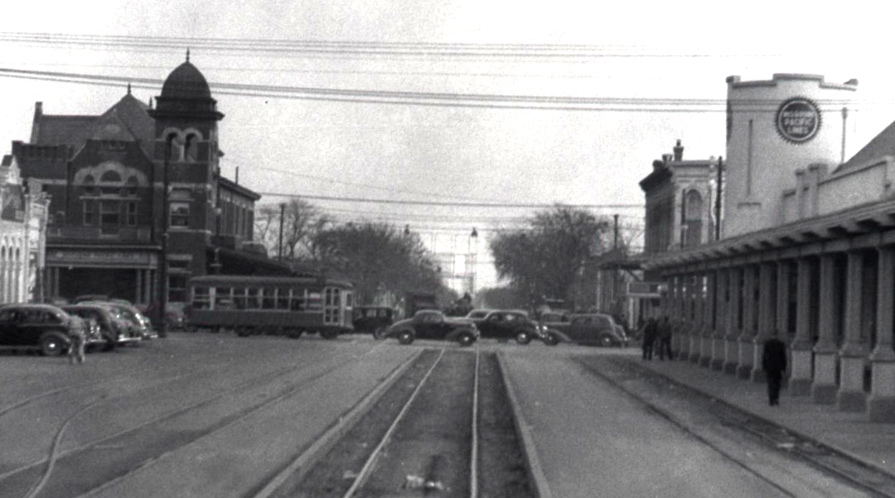
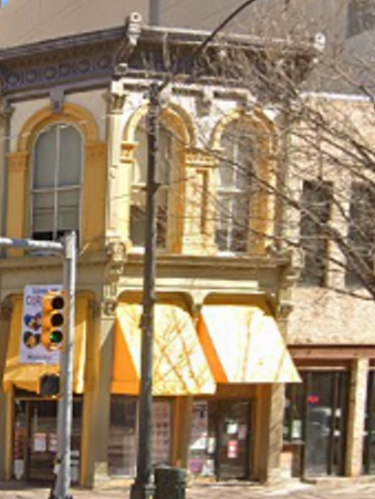
Above: In Barriger's next
photo taken about 1.5 miles farther west, his camera continues to face east as
his train is moving west on Third St. toward the river bridge. He has just
crossed Congress Avenue where the ornate SP depot (also used by the Katy) sat on
the northeast corner, and the MP depot sat on the southwest corner. Although both
depots are long gone, on the southeast corner, the arch-windowed building
(visible beyond the circular tower on the MP depot) was still standing when Google Street View caught this image
(above right) in February, 2021.
Barriger's train will proceed another half mile west and then take the east leg
of the wye to turn south onto the bridge.
Below: This could have been Barriger's next photo, but its
sequence number in the Barriger Library suggests that it was from an earlier
trip southbound on the Katy. His view is from the south side of the Colorado
River looking north along the I&GN bridge. The control tower is visible sitting in
the middle of the wye at the north end of the bridge. Barriger's trip south to
San Marcos will be on tracks that had been upgraded with automatic block
signaling. The May, 1929 issue of Railway Signaling
reported that the I&GN had
ordered automatic block signals from General Railway Signal Co. for the 36 miles
between Austin and San Marcos yard.


Above: Barriger took this photo passing through Austin on a northbound trip
on the I&GN. His train has just exited the Colorado River bridge, taken the west leg of the
wye, and has stopped now that Barriger's car has cleared the northwest switch of the
wye. Barriger's view is to the east on Third St.
which is occupied by tracks used by SP (and the Katy) that lead away from their
interchange with the I&GN toward the MP passenger depot farther
east. As MP's main line was west of the bridge and the MP depot was east of the
bridge, a back-up move was required for I&GN
trains, either inbound or outbound, to access the depot. Barely visible to Barriger's
camera is a
portion of the control tower's roofline (blue arrows) and short stretches of the east leg (pink
arrows) and west leg (yellow arrows) of the wye at the bridge.
Below: The next photo in
Barriger's sequence shows that he is approaching the Missouri Pacific passenger station (white building
with circular MP herald) as his I&GN train
backs east along Third St. Judging by the position of the
switch rails and Barriger's photo not being centered on the rails, his train is
taking the crossover to move to the south track used for access to the depot. By this time, the
I&GN had been owned by MP for many years, and the I&GN's separate identity was
rapidly disappearing.
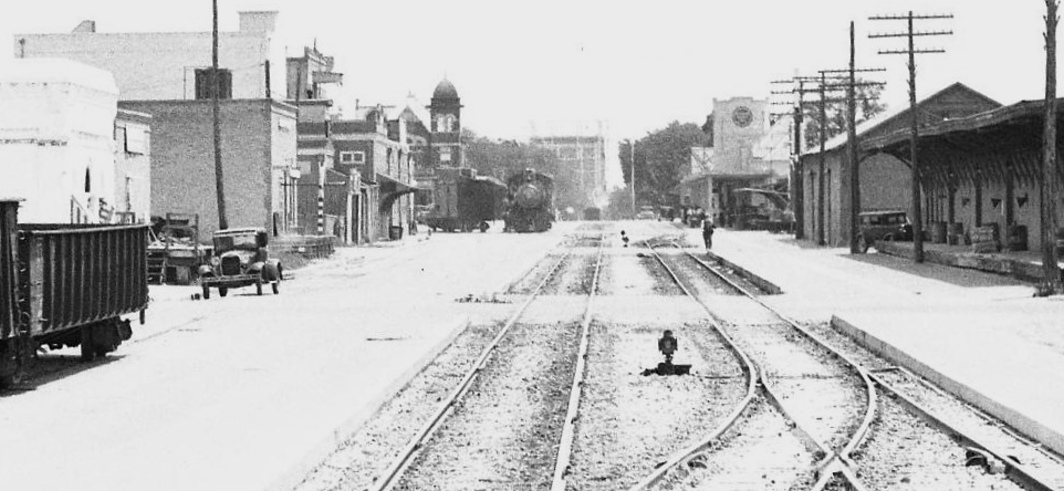
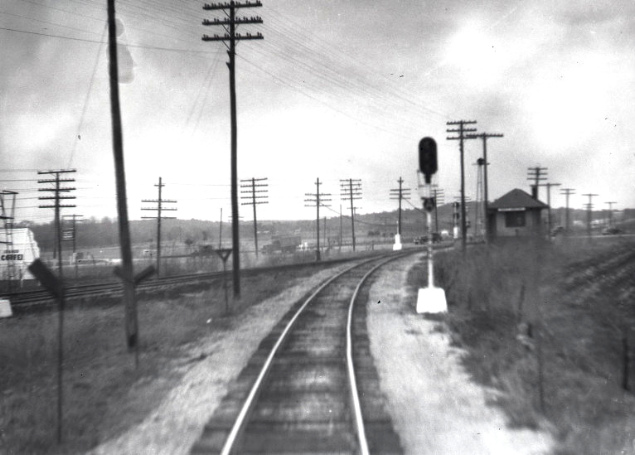

Above Left: Perhaps on the
same southbound Katy trip cited above, Barriger's train has taken the connector
off the I&GN at MKT Junction toward the Katy main line as he looks back at the
control cabin. In a half mile, Barriger's train will reach Ajax, most likely to
go south toward New Braunfels, but with the option to go east to Lockhart and
Smithville. Above Right: The
next photo in Barriger's sequence is looking back at the south lead of the wye
at Ajax. His train turned south at Ajax and is heading toward New Braunfels. The
position of the switch rails shows that his train came off the northeast lead
from MKT Junction to the left. The two faint telegraph poles on the horizon mark
the path of the Ajax wye connection between Smithville (right) and MKT Junction
(left).
Below Left:
On another trip, Barriger snapped this photo of MKT Junction from his
business car as his northbound Katy train has just come off the connector from
Ajax to head toward Austin on I&GN rails.
Below Right: Taken in 1980, this photo shows that a different
cabin now sits at "MK&T JCT" sporting a "Missouri Pacific Lines" circular herald
on the front. By this date, the junction was fully automated; the cabin housed
the interlocking plant and likely some override controls, but was normally
unoccupied. (H. D. Connor Collection)
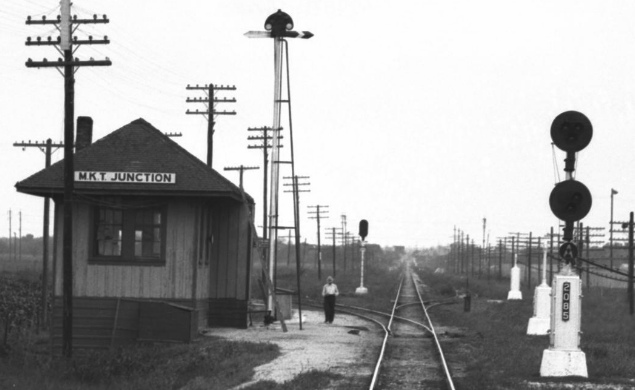
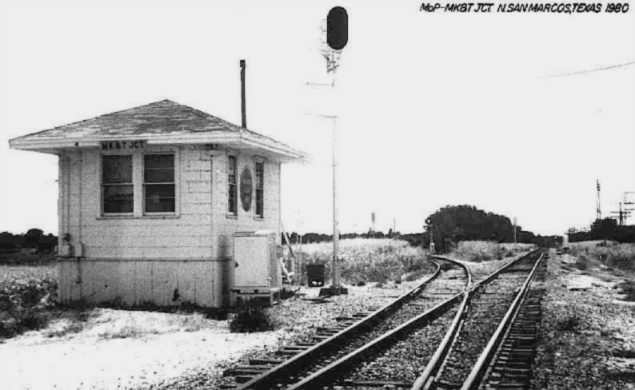

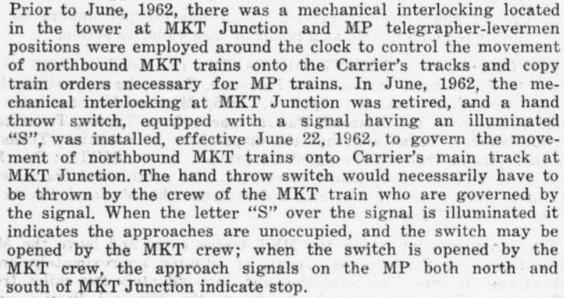
Above: The National Railroad
Adjustment Board (NRAB) was a body created by Congress to arbitrate labor
disputes in the railroad industry. These two excerpts are from an NRAB ruling
issued October 30, 1969 for a claim that had initially been raised by MP
telegraphers when some of their jobs were eliminated at MKT Junction in June,
1962. The essence of the claim was that between 6:30 am and 3:00 pm, Katy
telegraphers at the depot in San Marcos had begun copying and delivering train
orders to northbound Katy trains to be executed after the trains arrived at MKT
Junction, whereas previously, such orders were handled by MP telegraphers at MKT
Junction. The MP employees asserted that this violated their union's agreement
with MP. [How did the dispute end? Having failed to appeal MP's internal
decision (on the 1962 claim) to NRAB, their attempt to re-file the same claim in
1965 violated NRAB procedures and was disallowed.]
The above passages
from the ruling provide some basic history of the junction and its operations.
The background explains that the tower at MKT Junction had opened August 1, 1912
and had been staffed by MP personnel continuously since then, 24 hours daily. At
the time of the dispute, "...there was a mechanical interlocking located in
the tower...", presumably the plant that had been approved by RCT when
MKT Junction was assigned to be Tower 206 in RCT's numbering scheme (the precise
date of that assignment is unknown, but based on the timeframes for
Tower 204 and Tower 207,
it is likely to have been in 1956.) The switch and interlocker controls had been
operated manually by the MP "telegrapher-levermen" at MKT Junction, but
effective June 22, 1962, the railroads changed to a scheme wherein Katy train crews,
during morning and early afternoon hours when the cabin was not staffed, would receive their train orders
at the MKT depot in San Marcos. Upon arrival at MKT Junction, they would stop and manually operate
the
trackside switch. The switch was
connected electronically to the interlocker so that "...when the switch is
opened by the MKT crew, the approach signals on the MP both north and south of
MKT Junction indicate stop."
It is apparent from Barriger's photos
that there were home (and presumably distant) signals at MKT Junction long
before RCT approved the interlocker in 1956. The best guess is that since the
two railroads didn't actually cross at this junction, they had decided that RCT
approval of their switch and signaling system was not necessary. A nearly
identical situation existed with the control tower at the Colorado
River bridge. SP tracks (on which the Katy had rights) and MP tracks formed a
wye at the north end of the bridge but did not cross, hence the tower (which
presumably existed long before Barriger's visits) had never been incorporated
into RCT's numbering scheme. It officially became Tower 205 in the same 1956 timeframe
as Tower 206, suggesting that
MP (which managed both towers) had decided to comply with RCT interlocker
policies at these two junctions. Perhaps this was in response to
pressure (or a direct threat) from RCT, but it also seems reasonable to assume
that MP's exit from a lengthy receivership in 1956 (which dated back to the
1930s) played a role. The I&GN became fully integrated into MP when the
receivership ended, so that may also have been a factor.
It is interesting to note
that the focus of the labor dispute pertained solely to train order
communications for northbound Katy trains at San Marcos. Elsewhere, the ruling
mentions that southbound Katy trains (that would eventually take the switch at
MKT Junction) received their train orders from MP
telegraphers at Taylor, and that "...MKT's trackage rights were recently
extended to include...tracks between Austin and Taylor..." (approved
by the Interstate Commerce Commission on August 26, 1964.) Afterward, MKT trains
between Austin and
Temple began operating through Taylor instead of taking the Katy's route
through Georgetown (which meant that the Katy no longer served Georgetown and
Pflugerville.) The Katy tracks between Austin and Georgetown were formally
abandoned in 1976.
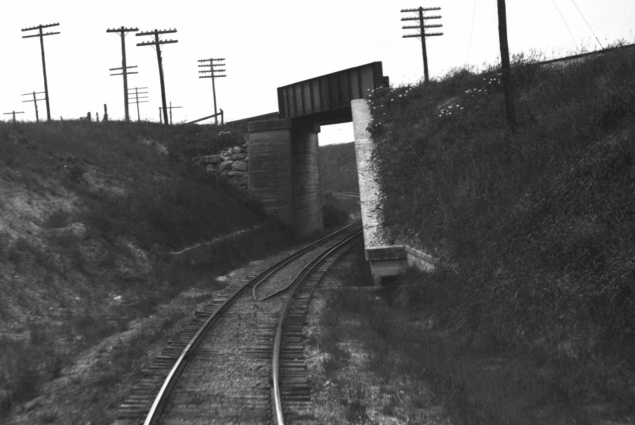
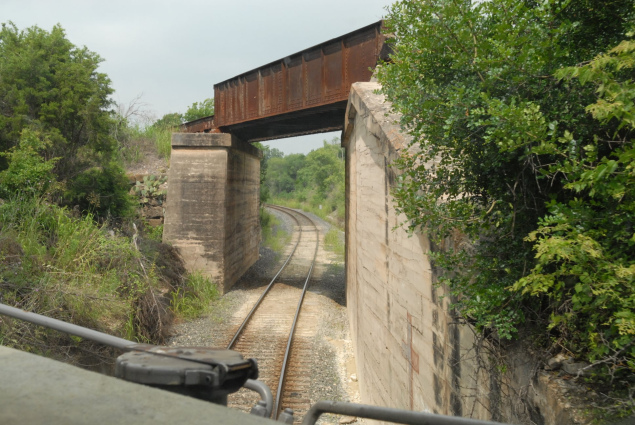
Above: About six miles south
of San Marcos, the Katy tracks crossed under the I&GN tracks near the community
of Hunter. On the other side, the lines resumed their parallel trek south
toward New Braunfels. As shown by these photographs taken approximately 70 years
apart by John W. Barriger III (left, c.1940, from the rear platform of his
business car on a northbound trip) and Bruce Blaylock (right, June 6, 2010, from
the cab of the UP locomotive he was piloting on a southbound trip), very little
has changed! Bruce describes this crossing: "At Mile Post 215.58 on the MP
(upper) track is an 85-foot skewed girder bridge built in 1915. As you can see,
the clearances are very tight and I never held my arm out of the cab while
running through Hunter Cut. A shifted load would be a real problem here. Some
years ago, the bridge was raised a few inches to accommodate double-stack
trains." Since there is apparently a local indication of the 1915 date
for the bridge installation, the obvious question is...was there always a bridge
here, i.e. was this the original track arrangement in 1901? The Katy tracks were
built 25 years after the I&GN tracks, and it's rare for the second railroad to
go under the first one. There's no indication (e.g. a creek bed or unusual
topography) that would convey the need for an I&GN bridge prior to the Katy's
construction. Since the Katy needed to move west of the I&GN tracks, the bridge
may have been added when the Katy was building south simply because there was no
less expensive way to do it. Rather than build a lengthy bridge, the Katy could
have paid the I&GN to raise their tracks (which are straight) onto a fill so the
Katy could cross beneath it. No evidence to the contrary has surfaced thus far, and
Hunter is not listed in any RCT documentation pertaining to crossings.
The positional swap of the rail lines (east for west) at Hunter did not disturb
their general southwest heading. So if the rail lines were near each other and
mostly parallel, how did they cross at nearly a right angle at Tower 92 in New
Braunfels? The culprit was the I&GN. The Katy tracks more or less maintain a
southwest heading on the entire route through New Braunfels, with short
adjustments at various places. The Katy crossed the Guadalupe River
geographically about where it would be expected, in the community of Gruene (less than a
half mile from the famous Gruene Hall dancehall which had already been hosting
live music for 23 years when the Katy showed up!) The Katy made one final
adjustment to a due south heading about three quarters of a mile north of the
crossing that became Tower 92's location and returned back to a southwest
heading just as it was crossing the I&GN at grade.
As can be discerned from the earlier map showing the rail lines between San
Marcos and New Braunfels, beginning northeast of New Braunfels the I&GN (the east line) takes a diverging path onto a
south-southwest heading,
gradually moving farther away from the Katy, continuing straight for nearly five
miles. This brings it to the Guadalupe River about a mile due east of downtown.
After crossing the river, the curve necessary to go back west into downtown
required a west-northwest heading because the river crossing had put the
latitude of the tracks a bit farther south than downtown. Continuing on this
heading, the I&GN crossed the Katy after passing through downtown and then
immediately began to curve back to the southwest to return to the original
heading toward San Antonio.
 Left:
The January, 1913 issue of The Signal Engineer
carried this news item reporting the I&GN's plans to install interlocking plants
at New Braunfels and Jacksonville. The New
Braunfels plant was installed in Tower 92 and commissioned later that year on
November 1, 1913. The Jacksonville plant was ... never bought? The first
appearance of Jacksonville in RCT interlocker records is dated eighteen years
later in 1931 when a 4-function interlocker was authorized to control the I&GN's
crossing of the St. Louis Southwestern ("Cotton Belt") with a swing gate tied to
an electric interlocker, similar to the later switch arrangement at San Marcos.
Left:
The January, 1913 issue of The Signal Engineer
carried this news item reporting the I&GN's plans to install interlocking plants
at New Braunfels and Jacksonville. The New
Braunfels plant was installed in Tower 92 and commissioned later that year on
November 1, 1913. The Jacksonville plant was ... never bought? The first
appearance of Jacksonville in RCT interlocker records is dated eighteen years
later in 1931 when a 4-function interlocker was authorized to control the I&GN's
crossing of the St. Louis Southwestern ("Cotton Belt") with a swing gate tied to
an electric interlocker, similar to the later switch arrangement at San Marcos.
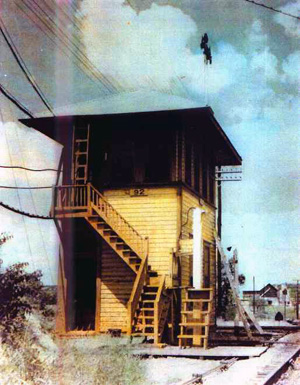
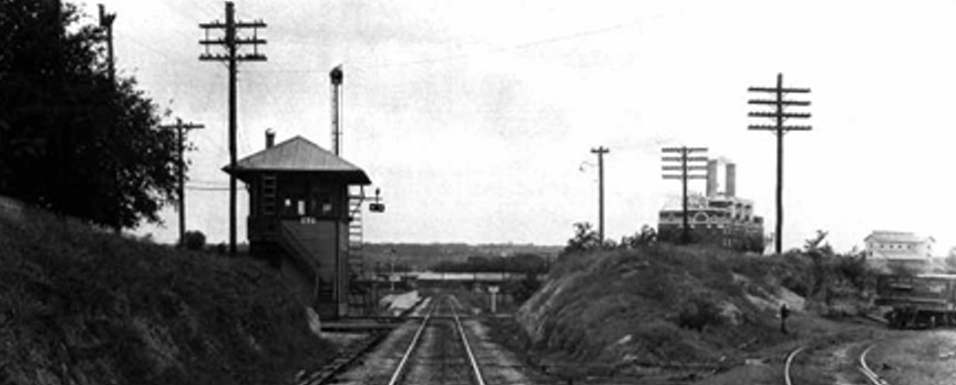
Above: Tower
92 controlling the Katy / I&GN crossing at New Braunfels was a manned,
2-story structure that housed a 23-function mechanical interlocker. These two
undated photos of Tower 92 face northwest, although the tracks in view are
southbound to San Antonio. RCT records from 1916 show that the tower was
operated by I&GN personnel, who would also have been responsible for
maintaining the tower and the interlocking plant. In
1957, the Interstate Commerce Commission (ICC) granted MP and the Katy permission to replace the Tower 92 manual
plant with an automatic interlocker. Presumably the tower was removed shortly
thereafter. (photos courtesy Jim Burns, New Braunfels Historic Railroad and
Modeler's Society collection) Below:
This June, 1983 photo by Jim Hinkhouse shows a young boy running toward a
northbound Katy train as it crosses the Tower 92 diamond. The automatic
interlocker cabinet to his right has a "92" placard (magnification at lower
right.) The control stand near the diamond allowed trainmen to override the
signals when necessary.
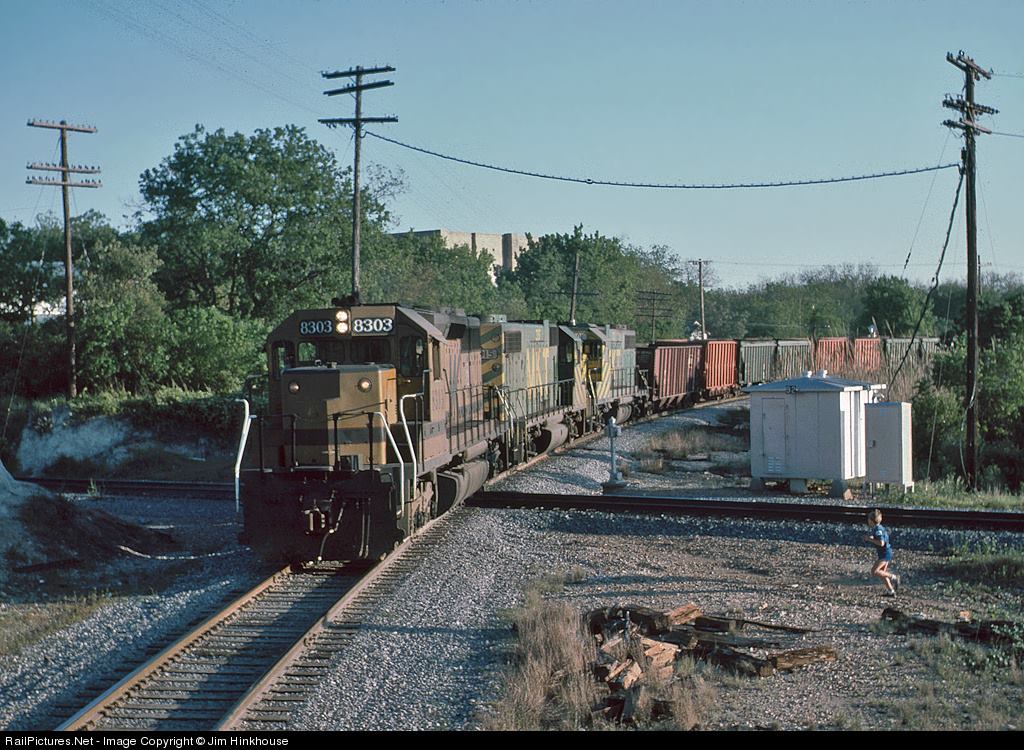
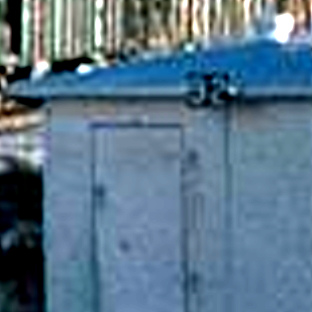
While George Gould maintained control over the I&GN and helped guide it into a
much stronger railroad over the next 15 years, financial clouds began to appear.
Part of the problem was that RCT had begun issuing regulatory orders requiring
specific railroads to improve physical infrastructure, safety and service with
new railcars, upgraded roadbeds and new depots. Arguably, some of these investments may not have been economically
justifiable, but to the RCT, they were required for public safety. The
I&GN had a terrible safety record, particularly on its line
between Spring and Fort Worth that had opened in 1903. Wayne Cline explains...
"Commission records [in 1908] showed that 99 wrecks had occurred on the I&GN since the
summer of 1907, and 41 of them happened...on the Fort Worth Division. ... The
International & Great Northern had compiled a reasonably acceptable safety
record, but it rapidly went downhill after the Fort Worth Division was
constructed. In 1904, casualties suddenly soared when 139 workers and passengers
were injured -- almost twice the average for the previous ten years. ... After
increasing markedly in 1904, derailments steadily mounted until five times the
normal average occurred in 1907."
The poorly designed roadbed on the Ft. Worth Division was not George Gould's only problem. An even larger issue was his
financially precarious situation resulting from the costs of major
rail expansions he had undertaken on the east and west coasts. When the
nation went into a sudden and deep depression caused by the
Panic of 1907, railroad revenues
fell
drastically. When the I&GN was unable to make payments on some of the
bonds issued during its reorganization in 1892, the I&GN went into voluntary receivership in
February, 1908. The receivership lasted three years during which the appointed
Receiver, Judge Thomas Freeman, a former T&P attorney, rehabilitated much of the
I&GN's roadbed and signaling systems using $11 million worth of short term
Receiver Certificates authorized for sale by the Court. In June, 1911, the Gould
family bought the I&GN out of bankruptcy and named Judge Freeman to be the new
President. Unfortunately, revenues were insufficient to retire the short term
notes he had issued as Receiver, hence the I&GN went back into receivership in
1914. And at that point, the Gould family connection to the I&GN ended forever.
It was not until July 28, 1922 that the reorganized railroad was bought out
of bankruptcy by a newly organized company, the International - Great Northern
Railroad (which explains why both I-GN and I&GN are
commonly used as abbreviations for the company.) The new I-GN had more than
1,100 miles of track, and it served most of the major cities across Texas
(lacking rails only to Dallas and El Paso; its rails to Galveston were via the
GH&H.) Its massive route structure through Texas made the I-GN an attractive
property, and the St. Louis San Francisco ("Frisco") Railroad tried to buy it in
1922. They were rebuffed by the ICC, which refused to approve the sale,
perhaps in part due to bitter opposition from MP and the evidence they presented during the
ICC's hearings. MP had been reorganized in 1917 and was no longer under Gould
control. It did not have any railroads in Texas and it had wanted to acquire the
I-GN to enter the Texas market directly (since it had not controlled any
railroads in Texas after its leases of the Katy and I&GN had been broken by
judges more than thirty years earlier.) The attempted sale of the I-GN had alarmed MP,
which had long cooperated
with the I-GN on St. Louis service to Houston, Galveston, Austin, San Antonio and Laredo. MP
tried to buy the I-GN directly in 1924, but again, the ICC nixed the sale.
Not to be deterred, MP executed its fallback strategy by helping to arrange
for the New Orleans, Texas & Mexico (NOT&M) Railway to buy the I-GN, simply to
keep it out of the hands of other competitors. The NOT&M had been formed in 1916
to own the Gulf Coast Lines (GCL), a syndicate of several railroads in south
Texas and Louisiana that had been owned by the Frisco prior to the Frisco's bankruptcy in 1914. The
GCL syndicate railroads all had financial commonality through the St. Louis
Trust Co., but they did not have the top-level executive structure of a
corporation -- individual GCL railroads had been managed cooperatively but
separately by Frisco executives. Since the GCL railroads remained viable, the
NOT&M was created to own and operate the GCL railroads
independently of the Frisco. The sale of the I-GN to the NOT&M was approved by
the ICC in June, 1924. MP was then allowed to buy
the entire NOT&M on January 1, 1925, thereby acquiring the target I-GN plus
all of the other GCL railroads. Among other things, the GCL component instantly
gave MP a major presence in coastal south Texas plus half ownership of the
primary switching railroad in Houston, the Houston Belt & Terminal Railway.
The
I-GN continued to operate under its own name within the MP family of railroads.
In 1933, MP and all of its subsidiaries went into a lengthy receivership largely
attributable to the Great Depression. The receivership did not end until 1956
when a new Missouri Pacific Railroad Company was formed, with all of its
railroads merged into it, no longer carrying separate corporate identities. The
T&P, however, was not merged, even though MP owned 75% of its stock. The T&P continued to operate cooperatively with MP until it was merged in 1976.

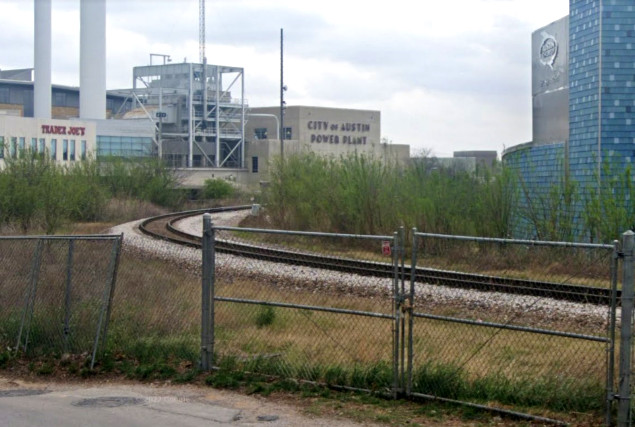
Above Left: This view looks
south from the County Rd. 235 grade crossing of the former I&GN tracks, with the
former Katy tracks to the left. The I&GN tracks are visibly rising to cross the
bridge at Hunter Cut while the Katy tracks remain level and gradually descend to
go through the cut. Above Right:
This view from Third St. shows that the tracks that formerly accompanied the
west leg of the wye at the north end of the Colorado River bridge in Austin have
been removed, as have all of the other tracks on Third St. east
of the bridge.
Below:
There is still a switch at San Marcos Jct., but the cabin is long gone. The
overpass visible in 2022 (left)
for Aquarena Springs Dr. opened in 2018, replacing the street grade crossing
that previously existed (right).
(Google Street View)
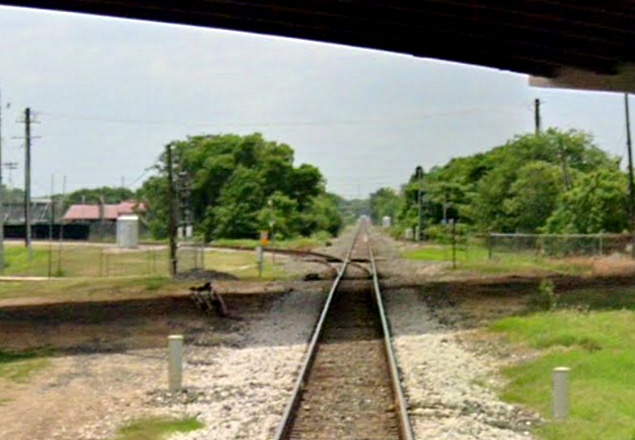
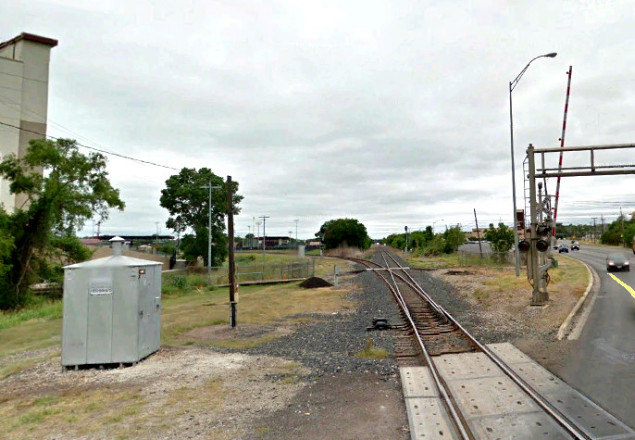
The Katy was able to stay independent but it was similarly
affected by economic downturns. The entire company entered receivership in 1915
and came out of it in 1923 under the name "Missouri - Kansas - Texas", hence both MK&T and MKT
are used as abbreviations. At that time, some of its routes were sold off or
abandoned, and some of its leases of other railroads were canceled. To
compete with the larger systems, the Katy began to consolidate management and
operations. The headquarters for the entire company was relocated to Dallas and
the Texas subsidiary corporation was dissolved. The railroad gradually abandoned
non-productive routes, but managed to remain in business into the 1980s. In
1988, it was purchased by MP, 100 years after MP had lost its lease on the Katy
due to the voluntary receivership undertaken by the new management after Jay
Gould had been ousted as President. MP was no longer independent; it had
been acquired by Union Pacific (UP) in 1982. In 1989, the Katy was merged into
MP and ceased to exist as a separate corporation. Similarly, MP was fully merged
into UP in 1997. Thus, UP owns and operates the remaining lines that had
I-GN and Katy heritage.
Under UP ownership, the original I-GN main line
between Longview and Laredo remains in service as do the former Katy tracks
between the Red River and San Antonio via Fort Worth, Waco, Smithville and San Marcos. East of
Smithville, the former Katy tracks no longer reach Houston; they terminate in
the town of Katy, 22 miles east of Sealy. The former Katy tracks between
Georgetown and Austin were abandoned in 1976, but the tracks from Granger to
Georgetown remain in place. They are owned by the recreated (1958) Georgetown
Railroad, and they continue to operate on the route originally built by the GRR
in 1878 to the former I&GN connection in Round Rock.















 The Katy
tracks through Smithville were within 50 miles of the I&GN tracks at San Marcos.
A line from Smithville west to San Marcos would provide benefits to Gould's railroads by
creating a triangle of track alternatives between Taylor, San Marcos and
Smithville that would be valuable in the event of a bridge failure or other
track problem. Most important, however, was that a Smithville - San Marcos
connection would eventually (when the eastward extension to Houston was
finished) create a Gould route between Houston and San Antonio via Smithville
and San Marcos. Such a route could compete with the GH&SA, and at minimum
would provide
a "Gould only" option for movements between two of Texas' largest
cities. As an added bonus, the town of Lockhart, worthy of rail service as the seat of Caldwell County, was
midway between Smithville and San Marcos. In 1887, MP initiated construction of
Katy tracks between San Marcos and Smithville via Lockhart. Work began at San
Marcos, and the tracks to Lockhart were completed in 1887. But like
the situation at Boggy Tank, further construction from Lockhart to Smithville was paused for
financial reasons.
The Katy
tracks through Smithville were within 50 miles of the I&GN tracks at San Marcos.
A line from Smithville west to San Marcos would provide benefits to Gould's railroads by
creating a triangle of track alternatives between Taylor, San Marcos and
Smithville that would be valuable in the event of a bridge failure or other
track problem. Most important, however, was that a Smithville - San Marcos
connection would eventually (when the eastward extension to Houston was
finished) create a Gould route between Houston and San Antonio via Smithville
and San Marcos. Such a route could compete with the GH&SA, and at minimum
would provide
a "Gould only" option for movements between two of Texas' largest
cities. As an added bonus, the town of Lockhart, worthy of rail service as the seat of Caldwell County, was
midway between Smithville and San Marcos. In 1887, MP initiated construction of
Katy tracks between San Marcos and Smithville via Lockhart. Work began at San
Marcos, and the tracks to Lockhart were completed in 1887. But like
the situation at Boggy Tank, further construction from Lockhart to Smithville was paused for
financial reasons.
 The Katy
now had tracks from the Red River to San Antonio
via Smithville, but did not serve Austin, the state capital. To do
so, it acquired two defunct railroads that had never laid tracks: the
Georgetown & Granger (G&G) Railroad and its owner, the Trinity, Cameron &
Western Railroad. The Katy did this to retire the G&G charter, which authorized
a line between Granger, on the Katy main north of Taylor, and Georgetown, the
county seat of Williamson County, 25 miles north of Austin. Retiring the G&G
charter enabled a new railroad to be chartered, the Granger, Georgetown, Austin & San Antonio Railway,
which built 16 miles from Granger east to Georgetown in
1903. At Georgetown, the Katy connected with a 10-mile I&GN branch line, the
former Georgetown Railroad (GRR) from Round Rock, which the I&GN had acquired out of foreclosure and merged in 1882. The Katy built the remaining distance to
Austin in 1904, going south through Round Rock, Pflugerville and
eastern Travis County before curving west to approach downtown. In July, 1905, the Katy negotiated rights to share the I&GN bridge over
the Colorado River along with 30 miles of I&GN track south to reach Katy's rails
at San Marcos. This enabled the Katy to provide direct passenger service between Austin and San
Antonio. Three months later, the
The Katy
now had tracks from the Red River to San Antonio
via Smithville, but did not serve Austin, the state capital. To do
so, it acquired two defunct railroads that had never laid tracks: the
Georgetown & Granger (G&G) Railroad and its owner, the Trinity, Cameron &
Western Railroad. The Katy did this to retire the G&G charter, which authorized
a line between Granger, on the Katy main north of Taylor, and Georgetown, the
county seat of Williamson County, 25 miles north of Austin. Retiring the G&G
charter enabled a new railroad to be chartered, the Granger, Georgetown, Austin & San Antonio Railway,
which built 16 miles from Granger east to Georgetown in
1903. At Georgetown, the Katy connected with a 10-mile I&GN branch line, the
former Georgetown Railroad (GRR) from Round Rock, which the I&GN had acquired out of foreclosure and merged in 1882. The Katy built the remaining distance to
Austin in 1904, going south through Round Rock, Pflugerville and
eastern Travis County before curving west to approach downtown. In July, 1905, the Katy negotiated rights to share the I&GN bridge over
the Colorado River along with 30 miles of I&GN track south to reach Katy's rails
at San Marcos. This enabled the Katy to provide direct passenger service between Austin and San
Antonio. Three months later, the 
























